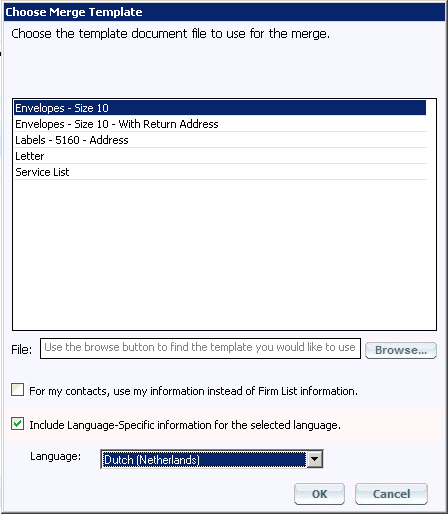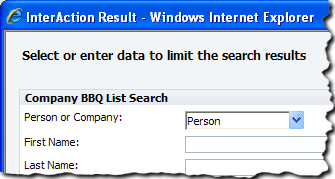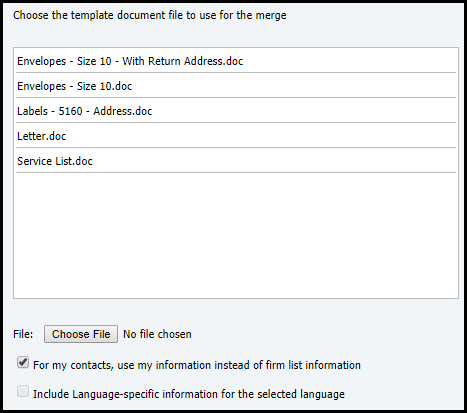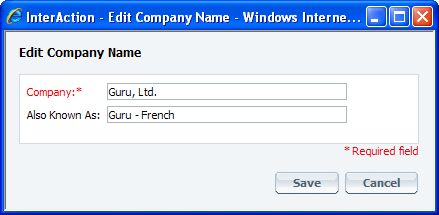Section Topics
Create Letters, Envelopes, or Labels from a List of Contacts
This describes launching a mail merge from within the Web Client. You can also do a mail merge using InterAction contacts from Word. See Using InterAction Contacts in a Mail Merge.
This feature uses Word’s mail merge functionality. InterAction exports the contacts, opens a document that contains placeholders for the various field values, then merges the exported data and the main document to produce the document.
-
From a contact list, select the contacts to include in the merge by selecting the check boxes to the left of the contact names.
-
Choose Actions > Create Letters, Envelopes, or Labels.
-
Select the template you want to use. If you would rather use a template saved on your machine, choose the Browse button to find the template file.
For more about creating your own template, see Create a Merge Template to Use with the Web Client .
-
If applicable, select the Include Language-Specific information for the selected language check box and then select the language from the drop-down list.
This option is available if your organization has configured InterAction for International Correspondence. Selecting this option exports language-specific information into merge fields you can use in your merge. See Using Language-Specific Information in a Mail Merge for more details.
-
Choose OK. Microsoft Word launches and downloads the results of the mail merge.
There are two files open in Word – the merged version (the final document) and the main document containing the placeholders. You can make changes to the main document and then manually “re-merge” the document as you normally would in the Microsoft Word mail merge functionality.
-
Print or save the document as needed.
Note: After you have finished with this mail merge document, you must close both Word documents before you can do another mail merge.

Mail Merge Document in Microsoft Word
[A] Select the contacts in the list and choose Actions > Create Letters, Envelopes, or Labels.
[B] Select the merge template to use.
[C] Word opens, performs the merge, and displays the merged document.
See the following topics:
- Using Language-Specific Information in a Mail Merge
- How do I Limit the Mail Merge to People?
- How Do My Regional Settings Affect the Addresses Shown in the Mail Merge?
- Which Phones and Addresses are Used in the Merge?
- Can I Do a Bilingual Mail Merge from the Web Client?
Using Language-Specific Information in a Mail Merge
If your organization has configured InterAction for International Correspondence, you can use the language-specific information for a particular language in your merge. This can be useful for ensuring that mailings are addressed correctly for different languages.
This only applies if InterAction has been configured for this feature. Also, the language-specific information for the contacts is entered and edited in the Windows Client; you cannot view or edit these fields in the Web Client.
To include language-specific information in a merge from the Web Client, select the Include Language-Specific information for the selected language check box and then select the language from the drop-down list when starting your merge.
This exports language-specific information into merge fields that can be used in the main document. However, note that these fields must be inserted in the main document to be used. Depending on how InterAction has been configured, these fields may or may not be used in the templates you can select from.
If necessary, you can create your own merge template in order to make use of the language-specific fields. See Create a Merge Template to Use with the Web Client .

Selecting the use of Language-Specific Information in a Merge
How do I Limit the Mail Merge to People?
Often when using mail merge to create letters, envelopes, or labels, you want to include just person contacts, not company contacts. You can do this by filtering the contact list before you perform the merge:
-
Start from a contact list. This can be your contact list, a contact type list, marketing list, working list, or a matters/opportunities/engagements contact list.
Note that most search forms also include the Person or Company criteria option.
-
Choose the Search This List link. Note that for the My Contacts list, this link is called Search My Contacts List.
-
From the Person or Company drop-down list, choose Person.
-
Enter any other criteria and choose Search.

This search criteria limits the results to only people. Select the contacts and create the letters, envelopes, or labels as described in Create Letters, Envelopes, or Labels from a List of Contacts.
How Do My Regional Settings Affect the Addresses Shown in the Mail Merge?
The out-of-the-box merge templates provided with InterAction use the merge field <<MailingAdrFormatted>>. This field automatically displays the contact’s address in the correct format for the contact’s country and your regional settings.
The addresses should look the same as they do when you view contacts in the Web Client. For example, if you set your country to France, addresses for contacts in the United States include the country when displayed in the Web Client or used in a mail merge. Addresses for contacts in France leave off the country information. If you were to switch your country to the United States, the reverse would happen.
For details about settting your regional settings, see Regional Settings.
Which Phones and Addresses are Used in the Merge?
Contacts in InterAction can have two different versions of phones and addresses: the information stored with your version of the contact, and the information stored with the firm’s version. This information can be different; for example, your version of a contact might have a home address, while the firm version has just the work address.
When you run a mail merge from the Web Client, InterAction needs to choose which version of the information to use. The following rules are used:
-
If you start the mail merge from your My Contacts list, your version of the information is always used.
- If the only contacts you select to include are in your list only, or if you start the merge from an overview page for a contact in your list only, your version of the information is always used.
-
If you start the mail merge from a different list or the results of a search, you can choose which version of the information to use. When selecting the template to use, select or clear the For my contacts, use my information instead of firm list information check box.

If this option is selected, your version of the information is used for all the contacts that are in your contact list. For contacts not in your list, the firm’s version is used.
If this option is not selected, the firm’s version is used for all contacts included in the merge. Note that the firm’s information may be available to all users or it may be available only to users with access to a particular list. For details about list-specific phones and addresses, see Creating List-Specific Phones and Addresses.
Can I Do a Bilingual Mail Merge from the Web Client?
If your organization has operations in French/English bilingual cities or regions such as Québec, Canada, InterAction may be configured to store company names in both English and French. In this case, the mail merge templates available for use with the Web Client may have also been modified to display the company name based on each contact’s preference. Depending on how this has been configured at your organization, this may only work with English and French.
If this feature has been enabled, then the English version of a company name should be recorded in the Company Name field and the French version should be recorded in the Also Known As field.

Each contact’s language preference should be specified in an additional field designated by your company.
To use this feature in a mail merge, the merge template must be set up to use the <<PreferredCompanyName>> merge field rather than the default <<CompanyName>> merge field. If your organization has not modified or added to the out-of-the-box merge templates, you will not see these changes.
When you do a mail merge using a template configured in this way, the value of the <<PreferredCompanyName>> merge field depends on the contact’s preferred language settings. If the contact is set to English, then the normal Company Name is used. If the contact is set to French, then the Also Known As field is used instead.

Note that the above only applies to contacts that are not in your contact list. For contacts in your own contact list, the version of the company name stored with your contact is always used when doing a mail merge from the Web Client.
